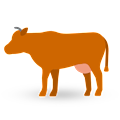Fore ribs
In English and German butchery, the fore ribs or vorderrippe represent a prime section of beef, hailing from the upper central part of the animal, situated between the thick rib and the sirloin.
This cut encompasses a set of ribs and the meat attached to them, offering a blend of marbled muscle and bone which together contribute to its pronounced flavor. Fore ribs are highly prized for their combination of tenderness and rich taste. The marbling – streaks of fat within the muscle – ensures that the meat remains juicy and flavorful during cooking.
Due to the presence of the rib bone, when roasted or grilled, the meat around the bone tends to be exceptionally succulent, as bones retain heat and cook the meat from the inside as well. Given its premium status, fore ribs are often reserved for special occasions or traditional Sunday roasts.
When cooked as a whole, it's commonly referred to as a "standing rib roast" or "rib of beef". When sliced into individual steaks, they're known as "rib-eye steaks", celebrated for their marbling and consequent juiciness. In British cuisine, a perfectly roasted rib of beef, with its exterior crisped to perfection and interior tender and pink, is a quintessential centerpiece, often paired with Yorkshire puddings, roast potatoes, and rich gravy.

